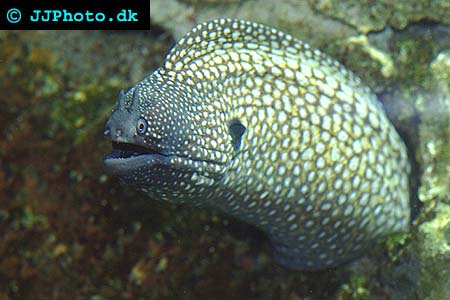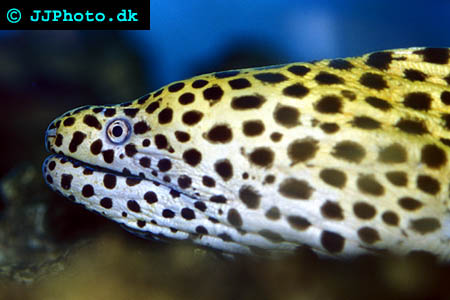Moray Eels

Moray Eels can be exciting and challenging marine life to keep. A big warning should go along with them. It can be dangerous to keep a moray eel, as they aren’t always the nicest of fellows.
Keeping a moray eel should be reserved for advanced aquarists, as they present challenges that aren’t found in many other fish. The main one is avoid getting bit. If scared, or frenzying over food, they may snap and bite anything. Furthermore, there is a high potential of infection due to both bacteria in the moray eel’s mouth, and that in the tank it’s within.
There are over 100 species of moray eels, however maybe 90% of them are not suitable for an aquarium for various reasons, including overly aggressiveness, unwillingness to adapt to a live in an aquarium, and that they grow too large for an average aquarium tank. Some moray eels get as large as 10 feet/ 3m (and up to 75 pounds/ 34 kg), and a small tank won’t unlike for some other fish species stunt their growth.
Some (though not all) moray eel are nocturnal predators. They have a good sense of smell, that compensation for bad eyesight. While it is possible to feed them from your hand, if they have adjusted to their environment and you, it’s not advisable as they might bite you when trying to get the food. Their mouth is open nearly all the time, and body and mouth are camouflaged to their usual environment.
Some good choices of moray eel are Zebra moray eel, Chain Link moray eel, Snowflake moray eel, Starry moray eel, Diamond Back moray eel, Banded moray eel, Dragon moray eel, Leopard moray eel, Gray moray eel, Jewel moray eel, Golden Tail moray eel, Spotted moray eel, and White-Eyed moray eel. All these species can be suggested for home aquarium use. Many of these species grows a little smaller (under 3 feet), and are therefore suitable for smaller aquariums.
When choosing a moray eel, Make sure that it eats in the store before buying it. If it isn’t eating there, you might have just as much trouble getting it to in your home aquarium. You should also look for injuries or sores, and avoid buying a fish if injuries or sores are present. Find out how their current home takes care of them. If it doesn’t sound right, ask why. You might be able to learn something new, or teach the present keeper something. (if experienced with them yourself).
Another aspect to keep in mind about moray eels is that they will try to escape from your aquarium. You must therefore secure your covers very well as they will squeeze through any hole they can fit there head in. If they can find a way out, you may just wake up one day with them on the floor dried out (dead). Among moray eel owners, there are a lot of experiences like that.
If you still have the desire to keep a moray eel, please read on.

Moray eel of the species Gymnothorax meleagris.
Copyright www.jjphoto.dk
Moray eels are a true eel (of the order Anquilliformes). In the wild they are omnivorous scavengers that tend to be somewhat territorial. You should therefore consider this when regarding how much room they need.
A moray eel holding tank needs to be relatively large. The exact size does however depend on the species you want to keep. The length and width of the aquarium are the two most important factors for moray eels while the aquarium height is of less importance. An aquarium for a small 3 ft (90 cm moray) species need to be at least 4 ft long and as wide as possible. If they feel crowded, moray eel are likely to try to escape. It may also lead to bad water quality as well, if it is truly crowded.
You should decorate your aquarium tank so that the moray eel has at least one or preferably several hiding places. If you keep several morays in the same aquarium it’s important to make sure that each moray can have its own hiding space.
Moray eels usually see other fish as meal if they are small enough to be eaten by the moray eel.
The water values for a moray should preferable keep a water gravity (salinity) of 1.022 to 1.025 and a temperature of 72 to 86 degrees Fahrenheit (22-30 degrees Celsius). The pH level should be kept above pH 8.0.
Moray eels produce a lot of waste matter which means that you will need good Chemical, Mechanical and Biological filtration going as well a good protein skimmer to keep the water quality up. You will also need to replace 20-25% of the water weekly to keep the water quality at top. (It might be enough to change about 10% of the water but a larger exchange is to be preferred)

Moray eel of the species Gymnothorax favagineus.
Copyright www.jjphoto.dk
Feeding a moray eel isn’t as hard as you might think. When younger feed them twice a week, and when they grow large once a week should suffice. It’s wise to do your weekly water change the day after you feed them, as it will help cycle out some results of the waste of the meal. If your moray eels are bred in captivity, they may be used to dead food, and need training to accept live food. Make sure it fits in their mouth, as they don’t chew. This means that you will have to chop up larger items into smaller pieces. Moray eels will accept a wide variety of foods such as shrimp, clams, and fish parts. (Look for details on the specific moray eel you choose online, or ask the personnel in a higher end fish stores that carry them to get a better idea what to feed yours).
When you first get the moray in your aquarium, you’re bound to see some strange behavior out of it. It’s quite not unusual that a moray eel spends some time sticking its head out of the water. This might be for the purpose of planning an escape. When the moray eel find a hiding place to their comfort, they will likely stick to it and keep fellow tank mates outside of it. It’s been suggested to keep the lighting low for their first few days might help the moray eel adapt to its new environment.
It is important that you keep an eye on your moray during the first time to make sure that it starts eating. Moray eels that refuse to eat are usually stressed and the problem can be solved by adding more hiding places for the eels. It should however be noted that moray eels can avoid eating for months in the wild which is a part of its normal behavior.
Related Articles
Black Dogface Puffer - Information about Black Dogface Puffer
Bowfin fish - An introduction to living fossils know as Bowfin fish
Boxfish- Information about Boxfish
Crocodile needlefish - An introduction to Crocodile needlefish
Dogface puffer - Information about Dogface puffer
Hogfish - Information about Hogfish
Lionfish - An introduction to lionfish.
Mandarin Goby - An Introduction to the Mandarin goby
Marine Betta - Information about Marine Betta (Calloplesiops altivelis)
Nudibranch - An introduction to Nudibranchs
Octopus aquarium - How to keep and perhaps even breed Octupus in an aquarium.
Pipefish - An introduction to pipefish
Saltwater aquarium fish - An introduction to marine aquarium. fish for beginners.
Sea horses in Aquarium - An article about how to keep sea horses in aquariums.
Sea star facts - Intersting and fun acts about sea stars such as the fact that they are in no way related to fish.
Sea Stars - An introduction to Sea Stars.
Clownfish Articles:
Black Clownfish - Information about Black clown fish
Breeding Clownfish - A very brief describtion on how to breed clownfish
Percula Clownfish - An article about how to keep and breed Percula breeding.
Tomato Clownfish - An in deepth article about tomato clownfish
Anthias
Aquarium Chillers
Basses
Batfish
Blennies
Butterflyfish
Cardinalfish
Clown fish
Corals
Damselfish
Files
Goatfish
Gobies
Gorgonians
Grammas
Groupers
Grunts
Hawkfish
Jawfish
Jellyfish
Lionfish
Dragonets
Mantis shrimp
Marine angelfish
Marine Catfish
Moray eels
Nudibranch
Octopus
Pipefish
Protein skimmers
Pufferfish
Rabbitfish
Rays
Snappers
Scorpionfish
Sea Anemones
Sea horses
Sea Stars
Shark Fish
Shrimps
Snails
Squirellfish
Surgeonfish
Triggerfish
Wrasses
